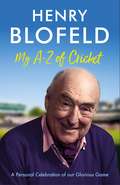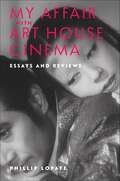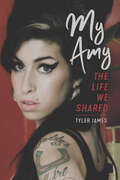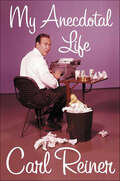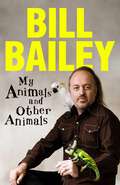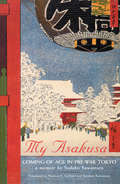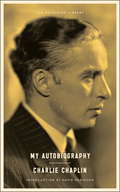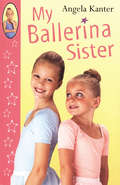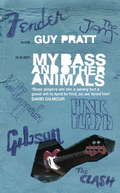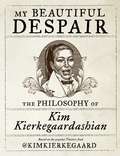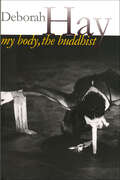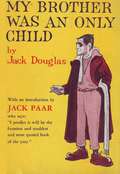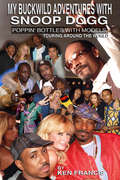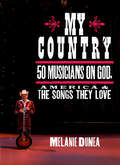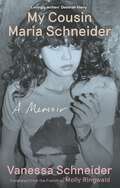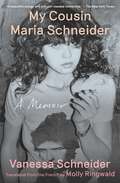- Table View
- List View
My A-Z of Cricket: A personal celebration of our glorious game
by Henry BlofeldLegendary cricket broadcaster Henry Blofeld takes the reader on a journey from A-Z through the world of cricket. In his trademark charming style, Blowers goes through the alphabet, explaining some of the puzzling cricket terminology and regaling his favourite anecdotes from his fifty years in the sport. This gift book is perfect for fans of cricket who want to understand the sport from Henry's unique point of view - this is a humorous and entertaining jaunt through the cricket landscape.
My A-Z of Cricket: A personal celebration of our glorious game
by Henry BlofeldLegendary cricket broadcaster Henry Blofeld takes the reader on a journey from A-Z through the world of cricket. In his trademark charming style, Blowers goes through the alphabet, explaining some of the puzzling cricket terminology and regaling his favourite anecdotes from his fifty years in the sport. This gift book is perfect for fans of cricket who want to understand the sport from Henry's unique point of view - this is a humorous and entertaining jaunt through the cricket landscape.
My A-Z of Cricket: A personal celebration of our glorious game
by Henry BlofeldLegendary cricket broadcaster Henry Blofeld takes the reader on a journey from A-Z through the world of cricket. In his trademark charming style, Blowers goes through the alphabet, explaining some of the puzzling cricket terminology and regaling his favourite anecdotes from his fifty years in the sport, covering the most important moments in the sport's history as well as the most entertaining and amusing. The book will also contain a glossary for those who want to make sure they know their googlys from their bouncers. This gift book is perfect for fans of cricket who want to understand the sport from Henry's unique point of view, it is a humorous and entertaining jaunt through the cricket landscape.(P) 2019 Hodder & Stoughton Ltd
My Affair with Art House Cinema: Essays and Reviews
by Phillip LopatePhillip Lopate fell hard for the movies as an adolescent. As he matured into an acclaimed critic and essayist, his infatuation deepened into a lifelong passion. My Affair with Art House Cinema presents Lopate’s selected essays and reviews from the last quarter century, inviting readers to experience films he found exhilarating, tantalizing, and beguiling—and sometimes disappointing or frustrating—through his keen eyes.In an essayist’s sinuous prose style, Lopate captures the formal mastery, artistic imagination, and emotional intensity of art house essentials like Yasujirō Ozu’s Late Spring, David Lynch’s Mulholland Drive, and Andrei Tarkovsky’s Solaris, as well as works by contemporary filmmakers such as Maren Ade, Hong Sang-soo, Hou Hsiao-hsien, Christian Petzold, Paolo Sorrentino, and Jafar Panahi. Essays explore Chantal Akerman’s rigorous honesty, Ingmar Bergman’s intimacy, Abbas Kiarostami’s playfulness, Kenji Mizoguchi’s visual style, and Frederick Wiseman’s vision of the human condition. Lopate also reflects on the work of fellow critics, including Roger Ebert, Pauline Kael, and Jonathan Rosenbaum. His considered, at times contrarian critiques and celebrations will inspire readers to watch or rewatch these films. Above all, this book showcases Lopate’s passionate advocacy for not only particular films and directors but also the joys and value of a filmgoing culture.
My Amy: The Life We Shared
by Tyler JamesA moving, intimate look at the life of Amy Winehouse by her best friend. The death of icon Amy Winehouse at age just twenty-seven rocked the music world. Through the headlines the world thought they watched a car crash: a girl hell-bent on self-destruction. But the truth is far more complicated. Now, her best friend and constant companion Tyler James wants to tell the real story, because she can't. From their first encounter singing together at stage school, through to their wayward teenage years and Amy's dramatic rise to stardom, Tyler was with her through it all. Living with her right up until her death, he was the only one there by her side, day-after-day. He supported her through her career highs—the massive success of Back to Black and her five Grammy wins—and personal lows—her lifelong struggles with addiction, insecurity, and eating disorders. Written with love, My Amy is a heartbreaking look at friendship and fame and provides an illuminating portrait of the woman behind the music—a unique, uncompromising force-of-nature.This is the definitive story of what really happened to Amy Winehouse.
My Anecdotal Life
by Carl ReinerOne of the most beloved figures in show business looks back on his life in short comic takes in this delightful memoir.“[Carl Reiner] has given us a veritable treasure trove of wonderful recollections, some side-splittingly funny and a few that are really touching. The best one is about me.” —Mel Brooks“You can't define genius, but it stands up and shouts from the pages of Carl Reiner’s My Anecdotal Life.” —Mary Tyler MooreIn this funny and engaging memoir, one of the best raconteurs on the planet recalls his life in show business in short comic takes. Reiner tells of how, after answering an ad for free acting classes on his brother Charlie’s advice, he forsakes a budding career as a machinist for an acting career. In “Sidney Bechet and His Jazz Band Meet Franz Kafka,” he captivates the legendary jazz man and his band with an unusual reading of The Metamorphosis, during a thunderstorm at a Catskills resort in 1942.Reiner also recalls the highlights of the succeeding decades: his first sweaty audition, impersonating a dog impersonating movie stars; his forays into the theater; his work on Your Show of Shows and The Dick Van Dyke Show during TV’s golden days; and his long friendship and collaboration with Mel Brooks which gave birth to the Two Thousand Year Old Man.In “A Recipe to Remember,” he recites a recipe for cream cheese cookies to a star-studded audience that includes Paul Newman, Leonard Bernstein, and Barbra Streisand. In “The Gourmet Eating Club,” he gives an insider’s take on the now-legendary group that included Mario Puzo, Joseph Heller, Zero Mostel, and other luminaries.Mary Tyler Moore, Sid Caesar, Mickey Rooney, Johnny Carson, Cary Grant, Dinah Shore, Ann Bancroft, Jean Renoir—the list goes on and on—also appear in what Reiner calls the “literary variety show” that captures the highs and lows of his extraordinary life. Through it all, Reiner displays the wit and warmth that have made him one of the most beloved figures in the entertainment business. This charming memoir will delight anyone who wants a behind-the-scenes look at five decades of Hollywood and television history.
My Animals, and Other Animals: A memoir of sorts
by Bill BaileyIn his first memoir, beloved comedian and national treasure Bill Bailey shares stories of his life - and the animals he's met along the way.Bill Bailey has always had dogs, including a Patterdale terrier called Rocky who would travel with him in the van to his first shows and occasionally join him on stage. Fast forward a few decades and Bill has shared his home with a variety of birds, dogs, frogs, chameleons and an armadillo called Tommy. 'We even had a giant chicken, a huge Malay cockerel called Kid Creole. After a few stand-offs he took against me. He had to go in the end, I was being stalked in my own back garden.'That chicken apart, animals have always been at the heart of an extraordinary life as one of the nation's favourite comedians, actors, musicians and (thanks to Strictly) dancers: from terriers to the orangutans of Sumatra and the parrots that share his breakfast every morning in west London.Full of the leftfield humour, wit and wisdom that has made Bill Bailey such a beloved performer around the world, My Animals and Other Animals is the story of Bill's life; but more than that, it's the story of how all of our lives are enriched by the animals who accompany us on that journey.
My Animals, and Other Animals: A memoir of sorts
by Bill BaileyIn his first memoir, beloved comedian and national treasure Bill Bailey shares stories of his life - and the animals he's met along the way.Bill Bailey has always had dogs, including a Patterdale terrier called Rocky who would travel with him in the van to his first shows and occasionally join him on stage. Fast forward a few decades and Bill has shared his home with a variety of birds, dogs, frogs, chameleons and an armadillo called Tommy. 'We even had a giant chicken, a huge Malay cockerel called Kid Creole. After a few stand-offs he took against me. He had to go in the end, I was being stalked in my own back garden.'That chicken apart, animals have always been at the heart of an extraordinary life as one of the nation's favourite comedians, actors, musicians and (thanks to Strictly) dancers: from terriers to the orangutans of Sumatra and the parrots that share his breakfast every morning in west London.Full of the leftfield humour, wit and wisdom that has made Bill Bailey such a beloved performer around the world, My Animals and Other Animals is the story of Bill's life; but more than that, it's the story of how all of our lives are enriched by the animals who accompany us on that journey.
My Asakusa
by Sadako Sawamura Norman E. Stafford Yasuhiro KawamuraWritten near the end of Sadako Sawamura's remarkable life, My Asakusa (Watashi co Asakusa) is a charming collection of autobiographical essays by a truly self-made woman. Recalling Japan at a time of great political turmoil and rapid cultural change, Sawamura shares with us her vignettes of growing up in Asakusa--one of the last of the old downtown Shitamachi neighborhoods of incessantly modernizing Tokyo--and her keen insight into the characters of those who populated her world.
My Autobiography
by Charlie Chaplin"The best autobiography ever written by an actor. An astonishing work." --Chicago Tribune Chaplin's heartfelt and hilarious autobiography tells the story of his childhood, the challenge of identifying and perfecting his talent, his subsequent film career and worldwide celebrity. In this, one of the very first celebrity memoirs, Chaplin displays all the charms, peculiarities and deeply-held beliefs that made him such an endearing and lasting character. Re-issued as part of Melville House's Neversink Library, My Autobiography offers dedicated Chaplin fans and casual admirers alike an astonishing glimpse into the the heart and the mind of Hollywood's original genius maverick. Take this unforgettable journey with the man George Bernard Shaw called "the only genius to come out of the movie industry" as he moves from his impoverished South London childhood to the heights of Hollywood wealth and fame; from the McCarthy-era investigations to his founding of United Artists to his "reverse migration" back to Europe, My Autobiography is a reading experience not to be missed.
My Ballerina Sister
by Angela KanterEmmy loves ballet but she isn't old enough to dance in her sister Charlotte's class. Then one day when she comes to watch the lesson she can't resist joining in. Before anyone realises, Emmy's doing pli-s at the barre - and she's doing them very well! Most of the class are thrilled by her dancing, but Charlotte isn't quite so comfortable about having a little sister who seems set to steal her limelight. When Emmy is given the coveted role of Spring in the annual show it seems the final straw for Charlotte, but then her teacher helps her to understand that although Emmy is very talented for her age, she can't dance as well as Charlotte, and Charlotte ought to feel proud that Emmy has learnt so much from watching her talented big sister.
My Ballerina Sister On Stage
by Angela KanterCharlotte is in for a nasty surprise when Emmy makes a new friend, Tom. For Tom's big sister, Icky Nicky, is in Charlotte's ballet class - and they hate each other! But when their sisters' fighting starts to get in the way of Tom and Emmy's friendship, they must find a way of bringing their warring siblings together, and ballet could be just the thing they need. And to Charlotte and Nicky's surprise, they soon find they have a lot more in common than they had realised.
My Bass and Other Animals
by Guy PrattGuy Pratt's life as bass player to the stars. The book behind the successful comedy show.Guy Pratt came of age just as playing bass became cool, with the likes of Paul Simonon and Bruce Foxton. Having dallied with Funkapolitan, Pratt suddenly found himself on Top of the Pops and supporting David Bowie with smooth Australian outfit Icehouse. At a ludicrously young age Guy Pratt became a sought after bass player to the stars, finding himself crawling from studio to bar, from hotel to stadium portacabin with Robert Palmer, Womack & Womack, Bernard Edwards, Bryan Ferry and David Crosby, etc. The eighties were in their prime, and with a number of Crolla-suited appearances in windswept videos behind him, he was invited to join Pink Floyd for a series of stadium of extravaganzas to make Bono & co look fairly modest. Pratt has recorded with Madonna, and spent time in the studio with Michael Jackson. He was in The Smiths for a week, has travelled through customs in a wheelchair after a flight with Jimmy Page, and has lived to tell all. MY BASS AND OTHER ANIMALS emerges from the successful stand-up tour of the same name. It charts his journey from a Mod band in Southend to playing with Roxy Music at Live 8.
My Bass and Other Animals
by Guy PrattGuy Pratt's life as bass player to the stars. The book behind the successful comedy show.Guy Pratt came of age just as playing bass became cool, with the likes of Paul Simonon and Bruce Foxton. Having dallied with Funkapolitan, Pratt suddenly found himself on Top of the Pops and supporting David Bowie with smooth Australian outfit Icehouse. At a ludicrously young age Guy Pratt became a sought after bass player to the stars, finding himself crawling from studio to bar, from hotel to stadium portacabin with Robert Palmer, Womack & Womack, Bernard Edwards, Bryan Ferry and David Crosby, etc. The eighties were in their prime, and with a number of Crolla-suited appearances in windswept videos behind him, he was invited to join Pink Floyd for a series of stadium of extravaganzas to make Bono & co look fairly modest. Pratt has recorded with Madonna, and spent time in the studio with Michael Jackson. He was in The Smiths for a week, has travelled through customs in a wheelchair after a flight with Jimmy Page, and has lived to tell all. MY BASS AND OTHER ANIMALS emerges from the successful stand-up tour of the same name. It charts his journey from a Mod band in Southend to playing with Roxy Music at Live 8.
My Beautiful Despair: The Philosophy of Kim Kierkegaardashian
by Kim Kierkegaardashian&“Reflective maxims on life, death, sin, and emptiness, salted with luxury accessories of the Kardashian lifestyle...@KimKierkegaard is dross turned gold, redemption through absurdity in a hundred and forty characters.&” –The New Yorker In &“the ultimate meeting of the sublime with the ridiculous&” (London Evening Standard) My Beautiful Despair blends the existential philosophy of Søren Kierkegaard with the superficial musings of Kim Kardashian West, based on the popular Twitter feed @KimKierkegaard. Kierkegaardashian shares thoughts on fashion, beauty, brunch, and the relentless waves of existential dread that wash over us day after day.A sample of the revelations include: – I have majorly fallen off my workout-eating plan! AND it's summer. But to despair over sin is to sink deeper into it. – Obsessed with protecting your skin, lips, hair & face from the sun? Close the cover of the coffin tight, really tight, and be at peace. – I like my men like I like my coffee: a momentary comfort in the midst of all my suffering. – What is the operation by which a self relates itself to its own self, transparently? Selfie. – What if everything in life were a misunderstanding, what if laughter were really tears? Scared LOL!! – I&’ve been going to bed a little bit earlier each night, to get a taste of death. In an age where the line between news and entertainment is blurrier than ever before, and the difference between a celebrity and the leader of the free world is nil, Kierkegaardashian&’s insights perfectly reflect our absurd, hilarious, and deeply disturbing new era. @KimKierkegaard has been admired, praised, and adored in The New Yorker, The Washington Post, The New York Times, Financial Times, The Economist, New York, Buzzfeed, and more, and has amassed nearly a quarter of a million Twitter followers, including J.K. Rowling and Anna Kendrick. Now in a humorous, illustrated gift book, perfectly suited for our existential times, Kierkegaardashian&’s philosophical insights are juxtaposed for the first time with Dash Shaw&’s brilliant black-and-white illustrations.
My Bike
by Byron BartonRide past trucks, buses, and cars.Pedal past monkeys, tigers, and lions.A bike can take you everywhere.
My Body, The Buddhist
by Deborah HayThrough a series of imaginative approaches to movement and performance, choreographer Deborah Hay presents a profound reflection on the ephemeral nature of the self and the body as the locus of artistic consciousness. Using the same uniquely playful poetics of her revolutionary choreography, she delivers one of the most revealing accounts of what art creation entails and the ways in which the body, the center of our aesthetic knowledge of the world, can be regarded as our most informed teacher. My Body, The Buddhist becomes a way into Hay's choreographic techniques, a gloss on her philosophy of the body (which shares much with Buddhism), and an extraordinary artist's primer. The book is composed of nineteen short chapters ("my body likes to rest," "my body finds energy in surrender," "my body is bored by answers"), each an example of what Susan Foster calls Hay's "daily attentiveness to the body's articulateness."
My Brain on Fire: Paris and Other Obsessions
by Leonard PittThis is Leonard Pitt's story of growing up the misfit in Detroit in the 1940s and 50s. In a later age he would have been put on Ritalin and paraded before psychiatrists because he couldn't pay attention in school. In 1962, at the end of a misguided foray towards a career in advertising he took the ultimate cure, a trip to Paris. He thought it would only be a visit. He stayed seven years. There in the City of Light, Leonard's mind exploded. And it hasn't stopped since.Studying mime with master Etienne Decroux and living in Paris were the university he never knew. This inspiration unleashed a voracious appetite to understand the "why" of things. He asked a simple question, "Why did the ballet go up?" While building a theatre career performing and teaching, he embarked on a quest to study the origins of the ballet, the history of early American popular music, the pre-Socratic philosophers, early modern science, the European witch hunt, the history of Paris, and more. To his unschooled mind it all fits together. Who would see a historical arc between Louis XIV and Elvis Presley? Leonard does. And he'll tell you about it.
My Brother Was An Only Child
by Jack Douglas Jack Paar"My Brother Was an Only Child" was Jack Douglas' very first humour book, having written for famous radio and television celebrities such as Jack Paar, Bob Hope, Bing Crosby and Jimmy Durante, as well as TV shows such as "Adventures of Harriet and Ozzie", "The George Gobel Show", and "Laugh-In". It perfectly captures the sense of humour prevalent in this era and is as refreshing and side-splittingly funny now as it was then.
My Buckwild Adventures with Snoop Dogg
by Ken Francis Joel RandellThis book is about Ken Francis and his Buckwild lifestyle with Snoop Dogg. His adventures as the right hand man of one of the most influential rappers of all times. Before there was Snoop Lion there was Snoop Dogg aka the Doggfather, one of hip hop's most iconic figures. And though the rap legend has rebranded and refocused his image, it is no secret that he made his mark by getting "buckwild." Film producer 'Pimpin' Ken Francis rolled exclusively with Snoop Dogg almost a decade ago, capturing and recording some of Snoop's most notorious moments in hip hop history via his trusty camera lens. Now he reveals the fun, insanity and angst of those long gone days with his new book, "My BuckWild Adventures with Snoop Dogg - Touring the World, Popping Bottles with Models." Edited by Maxim Magazine research editor, Joel Randell, "My Buckwild Adventures with Snoop Dogg" is a tell all tale that encapsulates life on the road with one of hip hop's most celebrated characters. The smoke, the women, the music and the celebrities all come together in this face paced recount of what used to make the newly named lion roar! With "My BuckWild Adventures with Snoop Dogg," Francis recalls those times and more, reliving first hand his experiences within the music industry and his life as Snoop Dogg's personal biographer. With never before published anecdotes about Magic Don Juan, Anna Nicole Smith, Ray J and Kim Kardashian, Leonardo DiCapricio, Bobby Brown and Whitney Houston to name just a few, Francis takes the reader on the road, in the green room, down the red carpet, behind the rope to VIP and around the world with insights and revelations about life with Snoop.
My Circus
by Xavier DeneuxAnother squeezably soft feast for the senses. Xavier Deneux turns another simple concept book into high art--this time treating readers to the wonders of the circus. Perfect for babies and toddlers, My Circus introduces clowns, magicians, trapeze artists, and many more familiar stars of the big top.
My Circus Family
by Mary Dixon Lake Alex Pardo DelangeHere's a big-top story with a tentful of surprises! Join the adventures of a little clown as he gets himself into everyone's act at the circus.
My Country: 50 Musicians on God, America & the Songs They Love
by Melanie DuneaNow in paperback, a volume of stunning photographs of 50 country music icons and intimate accounts of their thoughts on God, America, and their favorite songs.Award-winning photographer and author of My Last Supper, Melanie Dunea traces the throughlines from country music's gritty roots to the chart-topping chanteuses of today, presenting beautiful, imaginative, and revealing photographs of icons ranging from Taylor Swift to Wynnona Judd to Little Jimmy Dickens and conducting interviews that ask stars to discuss their musical roots and inspirations, their defining moments, and what makes country music the heart and soul of America.As the music industry fractures and suffers from flagging sales, country music has enjoyed explosive growth and unprecedented popularity. This totally unique book will be a must-own (and a perfect gift) for fans of the old time country twang and the millions who love the glitz and glamour of today's country-pop. My Country is a music-lovers dream, and in this more inexpensive, accessible market the book is sure to find its core audience amongst country music's legions of fans.
My Cousin Maria Schneider
by Vanessa Schneider"Lovingly written" Deborah Harry"An exquisite portrait of a tragic heroine" Violaine HuismanA spare, heartbreaking memoir and tribute to Maria Schneider, the 1970s movie starlet who catapulted to fame in the controversial film Last Tango in Paris-only to live the rest of her life plagued by scandal-as told from the perspective of her adoring younger cousin.The late French actress Maria Schneider is perhaps best known for playing Jeanne in the provocative film Last Tango in Paris, directed by Bernardo Bertolucci and released to international shock and acclaim in 1972. It was Maria's first major role, alongside film legend Marlon Brando, when she was barely eighteen years old. The experience would haunt her for the rest of her life, traumatizing her and sparking a tabloid firestorm that only ceased when she began to retreat from the public eye nearly two decades later.To Maria's much younger cousin, Vanessa Schneider, Maria was a towering figure of another kind-a beautiful and fearsome fixture in Vanessa's childhood, a rising star turned pariah whose career and struggles with addiction won the family shame and pride in equal measure. Here, Vanessa recounts the challenges of their overlapping youths and fraught adulthood and reveals both the tragedy and inevitability of Maria's path in a family plagued by mental illness and in a society rife with misogyny.Unsentimental and suffused with deep love, My Cousin Maria Schneider is the story of a talented artist and the cousin who admired her, and of exploitation and how its lingering effects can reverberate through a lifetime.
My Cousin Maria Schneider: A Memoir
by Vanessa Schneider&“A beautiful eulogy and a much-needed corrective&” (The New York Times)—a love letter to Maria Schneider, the 1970s movie starlet who catapulted to fame in the controversial film Last Tango in Paris—only to live the rest of her life plagued by scandal, as told from the perspective of her adoring younger cousin.The late French actress Maria Schneider is perhaps best known for playing Jeanne in the provocative film Last Tango in Paris, directed by Bernardo Bertolucci and released to international shock and acclaim in 1972. It was Maria&’s first major role, alongside film legend Marlon Brando, when she was barely eighteen years old. The experience would haunt her for the rest of her life, traumatizing her and sparking a tabloid firestorm that only ceased when she began to retreat from the public eye nearly two decades later. To Maria&’s much younger cousin, Vanessa Schneider, Maria was a towering figure of another kind—a beautiful and fearsome fixture in Vanessa&’s childhood, a rising star turned pariah whose career and struggles with addiction won the family shame and pride in equal measure. Here, Vanessa recounts the challenges of their overlapping youths and fraught adulthood and reveals both the tragedy and inevitability of Maria&’s path in a family plagued by mental illness and in a society rife with misogyny. Unsentimental and moving, My Cousin Maria Schneider is a love letter to a talented artist and the cousin who admired her, and a powerful story of exploitation and how its lingering effects can reverberate through a lifetime.
